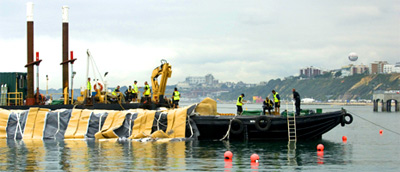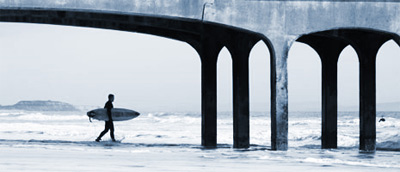Words by: Tiffanie Wen
Illustration by: Eve Bracewell
Musing on the concept of an ‘artificial reef’ might turn our thoughts to a chlorine-filled sea and beach made out of plastic sand which, even though it doesn’t get stuck in our bikini bottoms in the pesky way that real sand does, seems so very wrong. Mad scientists bent over Bunsen burners and glass test tubes mixing up smoky and colourful ingredients behind a curtain somewhere, trying to figure out how to create an even more beautiful sunset. Perfectly formed waves break 300 metres from shore and are ridden by some of Europe’s best landlocked surfers, some with fake boobs, others with fake tans, before lapping gently on to the crowded beach.
It seems a million miles from the beach and natural world as we know it. But is the building of Europe’s first artificial reef on the south coast in Boscombe, near Bournemouth, taking us towards a surfing world that’s unsettlingly close to Disneyland? Well, not exactly. Though most surfers might not take to the word ‘artificial’ or ‘fake’ very well initially, the Bournemouth reef won’t really be made out of anything fake.
“An artificial reef was built using tyres back in 1993 and when I spoke to the local council about it then they were quite interested,” says David Weight, a surfer of 40 years and the brains behind the Boscombe reef that’s been dubbed ‘Weight’s’. “But then I heard about a group based in New Zealand who was looking to build a reef using sandbags wrapped in a geotextile material.”
The reef is costing Bournemouth £2 million and is being built by a New Zealand company called ASR, the world leaders in reef research and design. ASR’s founder, Dr Kerry Black, spent eight months designing and testing the reef in the lab. Black is a surfer based in Raglan, NZ (remember where The Endless Summer boys found their perfect break?) and designed the reef to maximize its surf quality – waves will be 1.5 times bigger, break about 300 metres from the shore, have a deeper and more hollow shape and rides will last longer, for about 70 metres. “The reef essentially acts like a ramp, pushing the water up and forcing it to break earlier and in a particular direction,” says Black. “Bournemouth gets quite a lot of wind, so we put a little left on it to try to knock out some of the chop. But the main wave is the right which is running away from the wind.”

While reefs in the past have been made out of tyres or cement blocks, the reef at Bournemouth will be made out of a fibrous bag filled with sand, which plants can cling on to. Reefs made in Australia and New Zealand using the same method have become a habitat for marine life, and the Bournemouth reef is expected to do the same.
“In Australia we’ve had everything from turtles to manta rays and lots of fish so it has been a fantastic outcome for the ecology, and it’s been the same in the Mount Maunganui reef in New Zealand,” explains Black. “The ecology is just astonishing. A reef provides a fixed substrate, a stable object, whereas on most sandy beaches, every time the tide comes in the sand’s moving all around and things can’t grow very well.”
Artificial reefs, like real reefs, also provide coastal protection to the beach in addition to improved surf. Since waves break sooner, most of the energy and damaging effects of the water are diminished by the time they hit the beach. There’s a good chance that artificial reefs might become the preferred method of coastal protection in the future. “We may have to use other means of coastal protection later,” begins Weight. “They’re going to take measurements and see how it works out and see what the response is, both from the public point of view and from the effect on the coastline, and compare the advantages of the reef with groins.”
In general, better surf is welcome by locals. Some of the more serious surfers in the area consider themselves no better off than surfers in London. A series of beach replenishments at neighbouring Southborne ruined the sandbar that created surfable waves there, so most surfers in Bournemouth trek down to Cornwall when they’re looking for a good session.
Sophie Chambers is a 23 year-old surfer who grew up in Bournemouth. “As it is now Bournemouth is rubbish and hardly ever works. It’s really messy and short. There’s no point surfing there. Occasionally there might be a really good day, but I’ve never seen one,” she says.
26 year-old Helen Keeling used to lifeguard at Bournemouth beach and is one of the many local surfers who makes the regular pilgrimage to Cornwall. “There’s definitely a bigger demand for good surf here,” she says, “Most people travel down to Cornwall but it’s a long way to go and petrol’s expensive so if there were more days and better surf here than that would be brilliant.”
The reef is primarily designed to improve the quality of surf during mid-sized swells, at about 1.5 metres, and will be best around mid tide. But if it works on really small days too it has the potential to double the days of surf. The reef is the cornerstone of a £9 million regeneration project, which includes a refurbished pier and 1960s bathing station, restaurants and shops, and beach bungalows. The project is already having a positive impact on the Boscombe suburb, with land and property values rising sharply. A design-winning development of luxury flats, which have sold for up to £895,000 apiece, has been named The Reef, while another developer is working on a building called The Wave. Boscombe relies heavily on tourism but has in recent years become a haven for drug use and deprivation. Whereas Newquay turned down a proposal for an artificial reef, in part because the success of an enhanced wave would bring overcrowding to an already touristy area, increased tourism in Boscombe might just save it. Residents are optimistic too.

“Boscombe used to be a really wicked place,” says Joel Whitmore, who’s lived there all his life. “It had a good reputation and was one of the best places in Bournemouth. But now it’s overrun with drugs and nasty stuff. The tourism will give it a face lift and a good name again.”
Bournemouth councillor Roger Brown estimates that the direct spend of the reef will be worth £2.5 to £3 million a year and create about 100 jobs. “But we estimate the publicity value is worth £10 million a year and we’re confident it will regenerate Boscombe,” he says.
The economics are all well and good, but does the idea of an artificial reef ruin the romance of surfing? “I don’t think it takes away from the experience of surfing,” says Weight. “In a sense the reef is what it is. The waves themselves, their variability, the tides and the currents will still be there. Each swell will have its own unique characteristics which are natural.”
Alex Dick-Read, Editor of Surfer’s Path, agrees, “Does an artificial reef ruin the soul of surfing? Not really, in my opinion. It’s not faking it in the way a wave machine is. It’s just bending swells to your advantage by altering the bathymetry – something that both man and nature do all the time. In nature, beach breaks can go from epic to useless in a cycle of shifting sands, and reefs grow, die and get altered. Surf breaks morph all the time.”
But local Sophie might best sum up the attitude of her fellow Bournemouth surfers. “For me, it does take away the spirit of surfing but if it’s a wave it’ll make people happy,” she says. “And hey, if there’s a good wave on my doorstep, I’m not going to say no.”
Check out this clip of the Bournemouth artificial surf reef modelling…
http://mpora.com/videos/Z76Y6e0YC
More Surfing Videos >>
We’re well into the artificial reef in Bournemouth, but here’s a list of fake things we certainly don’t care for…
1. Indoor surf beaches
Although some people say that surfing in a huge vat of chlorine is fun, we say we’d miss the sting of the salt. Not to mention the sun and the sky.
2. Fake tans
We just can’t wrap our heads around the whole tan in a bottle phenomenon, especially as it so often turns the unsuspecting user day-glo orange. Besides why would anyone want to get rid of their wetsuit tan anyway?
3. Fake boobs
They get in the way when you’re surfing, float in a really weird manner and basically give us the heeby jeebies. Keep it real girls, keep it real.
4. Indoor snow slopes
While bright lights inside a gigantic warehouse might appeal to some people when they’re boarding, we prefer to take on the elements – on a real life mountain. Plus they often divert an insane amount of water from the mouths of people who really need it.

